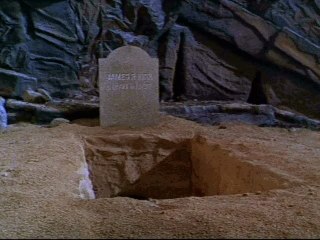
Back in 1966, NBC was unhappy with
Star Trek's original pilot, "The Cage" calling it "too cerebral" for network television. But they liked the potential of it and asked Gene Roddenberry to go back to the drawing board and create a second pilot with a bit more action. Roddenberry did and of the three or four scripts he could have picked, he chose what eventually became "Where No Man Has Gone Before" as the second pilot.
And the rest, as they say, is history.
It's historic that NBC would ask for a second pilot for a show--something that had never been done before and has rarely been done since.
"Where No Man Has Gone Before" looks very different from the
Trek we'll come to know and love over the next three years--at least visually. The uniforms are different, the sets are slightly different and there's no McCoy yet. (He'll be cast for the series second episode "The Corbomite Manuever.")
So why would an episode that's a second pilot make the top ten?
Because it's a heck of a story to start out the series run. It's a great blend of action (which NBC wanted) with the cerebral parts that doomed "The Cage" hidden in there as well.
The premise is a fairly straight-forward one. Following in the footsteps of an earlier mission to leave the galaxy, the
Enterprise encounters an energy barrier. The barrier causes massive system failure in the ship, leaving the ship crippled and limping back toward Federation space (the warp drive is down and it could take months, if not years to get back). But of greater concern is Kirk's best friend, Gary Mitchell (played by
2001's Gary Locklear) who is zapped by the barrier and starts to exhibit enhanced, almost god-like powers. And the ego and ambition to go with them. Mitchell slowly starts to become too powerful for his own good, leaving Kirk with a dilemma--should he have to kill his best friend to save the ship and possibly the universe?
A solution presents itself to both problems--a lithium cracking station on Delta Vega. They have the equipment to repair the ship and it's deserted. Kirk can strand Mitchell there, provided he can get Mitchell off the ship. Things go from bad to worse when another crew member, Dr Elizabeth Dehner (play by Sally Kellerman) begins to develop the same powers as Mitchell (both have high ESP ratings, which is what triggers the power's on-set).
In the end, Kirk must battle and kill his friend after Dehner sacrifices herself trying to stop Mitchell.
There's a lot going on for the first episode of a series, though this is not the episode NBC chose to start the show. I can only imagine what it was like in 1966 for this one to be aired third since visually it is hugely different from anything around it.
But what shines through are the characters. Yes, they're still defining and refing Spock here and while he and Kirk aren't best friends yet, the groundwork is being put in place. The dilemma Kirk faces here--save the ship, abandon and possibly kill his friend is one that weighs on him. We get one of the first great Kirk/Spock debates about the fate

of Mitchell. And to add to it, the action sequences are pretty good as well, leading to the first ripped shirt on Kirk.
It also features a cotinuity error--when Mitchell creates a grave and headstone for Kirk, it reads "James R Kirk" instead of "James T Kirk." This little error has been explained numerous times in numerous novels over the years, but it's still kind of fun.
A great start to a series that would last far beyond its three-year run. "Where No Man Has Gone Before" is one of the more entertaining and intriguing episodes of the early run of S
tar Trek.Labels: Star Trek
posted by Michael Hickerson at 8/30/2006 07:10:00 AM |
|